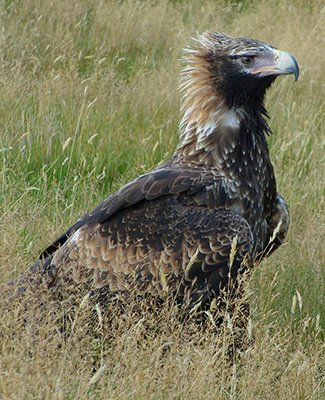Tasmanian eagles are recent migrants

THE TASMANIAN WEDGE-TAILED eagle probably flew to the island just a few hundred years ago, a new study concludes.
It has long been presumed that the Tasmanian subspecies of Australia’s largest bird of prey (Aquila audax fleayi) evolved on a separate path to the mainland species, after becoming trapped in Tasmania by rising sea levels roughly 15,000 years ago.
Adults of the threatened subspecies look distinct from mainland wedge-tailed eagles, differing in size, colour and behaviour.
Eagles’ Bass Strait flight
However, a team led by scientists at the University of Tasmania and the University of Adelaide have shown that the genetic relationship between the two indicates a diversion merely hundreds of years ago, implying mainland wedge-tailed eagles simply flew across the Bass Strait to Tasmania.
Over the course of four years, the scientists tested the DNA of 224 individual birds — 49 from the mainland and 175 from Tasmania — the majority of which were preserved in museum collections. They quickly discovered that there is much less genetic variation among Tasmanian wedge-tailed eagles than expected, signifying a short isolation.
“Based on the rate of genetic variation in other isolated species around the world, we now know the wedge-tailed eagle first arrived in Tasmania long after the melting of the last Ice Age, which created the geographical separation,” says Dr Chris Burridge, a University of Tasmania zoologist and lead researcher on the study.
Tasmanian museum collections
Chris is confident in the team’s findings on the level of genetic variation, as the 175 Tasmanian eagles sampled represent a significant proportion of the subspecies’ entire population.
“The Tasmanian wedge-tailed eagle is a threatened species and more than 150 dead eagles have accumulated in collections over the last 15 years,” he says. “We could have potentially had 19 per cent of the entire subspecies in our possession.”
The substantial difference in appearance to mainland birds could have developed because only a small, specific group of wedge-tailed eagles flew over to Tasmania.
“If a certain type populated Tasmania, then a morphological difference would have developed almost instantaneously. That wouldn’t take more than a hundred years,” Chris told Australian Geographic.
This type of movement across the Bass Strait is nothing new, he says. It has already occurred with the eastern ground parrot (Pezoporus wallicus) and white-bellied sea eagle (Haliaeetus leucogaster).
Dr Steve Debus, an ornithologist at the University of New England in Armidale, NSW, says that the subspecies was thought to suffer from inbreeding, so the new finding about how it was founded makes a lot of sense.
The discovery will also help experts come up with a better plan for how to conserve the population. “With the loss of the thylacine and decline of the Tasmanian devil, the eagle is now the top predator in Tasmania and is therefore ecologically important,” says Steve .
Unexpected island biogeography
Chris hopes that this study will inspire a new way of thinking among evolutionary biologists.
“There are many other islands that have at one time had land connections to adjacent continents. This study is a good example of why we shouldn’t assume that things that look different on islands are actually that different — we may be underestimating their travel capabilities,” he says.
Dr Leo Joseph is the director of research at the CSIRO Australian National Wildlife Collection in Canberra. He says this “is a fascinating example of the sometimes unexpected windows that genetic data can open into a population’s history, especially those on islands.”
Leo agrees that now we know the decline has in part been caused by inbreeding, we will be much better placed to manage the population.
RELATED STORIES

